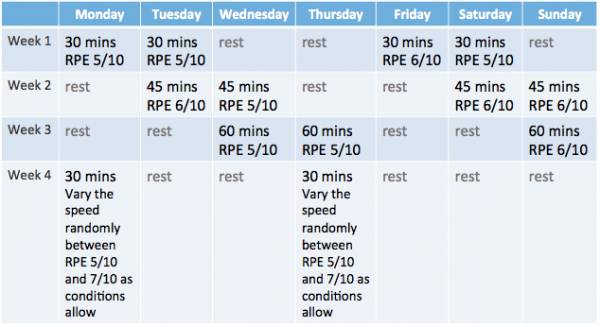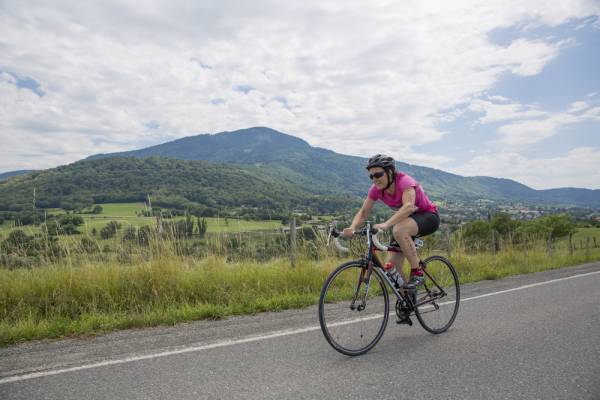Here in the Northern Hemisphere, the days are certainly getting longer and the weather a little warmer. You might be considering getting your bike out of the shed in order to get a bit fitter during the coming warmer months. But in case you have not been doing much activity recently, here are some tips to get you off to a good start.
In this beginner program, I show you how to check and set up your bike and include a short plan to help you become re-accustomed to cardiovascular exercise and either learn or re-learn how to pedal correctly. I have kept in mind that you may not have been cycling for a while, so the sessions are only up to an hour in length to avoid long periods of possible discomfort on the saddle.
Getting Started
First, give your bike a good check over and a service. Having gears that stick, brakes that squeal, or a creaking chain will spoil any enjoyment – and only make things harder. Here is a quick checklist. I am sure your local bike store will be only too pleased to help out, as well.
- Adjust the gears so you can select all of them easily and without the chain falling off the rear sprockets.
- Oil the chain with some light oil or proper chain lubricant. If it is rusty or worn, it is better to replace it.
- Check all the teeth on the sprockets and chain rings. Missing or worn teeth or bent chain rings indicates replacement is necessary.
- Check all the spokes are an even tension and not loose. If any are loose or broken, ask for some help from your local bike store. Do not ride with broken spokes.
- Check the brake pads are not worn down and the brake lever action is smooth. Seized and stiff cables should, as a minimum, be lubricated or, even better, replaced.
- Check the tires are not worn or cracked because of old age and that they hold their pressure. A good pump is a worthwhile investment.
- Check the front headset bearing by putting on the front brake and trying to push the bike backward and forward. Looseness in the front steering indicates that some adjustment or new bearings might be required.
- Check the bottom crank bearing by holding the crank and trying to push and pull it away from the cycle sideways. Looseness indicates that some adjustment or new bearings are required in the bottom bracket bearing.
- Finally, check that you can adjust the seat height by loosening the seat post clamp screw and sliding the seat post up and down. If it is seized, then some specialist attention might be required.
Having checked the bike over and resolved any issues, you now need to check the bike fit. Your local bike store might be able to help you with this, but a good starting point is to adjust the seat height and horizontal forward-backward position.
Beginning Training Schedule
Having sorted out any issues with the cycle, we now turn to the proposed training schedule. If you have not been active for a while, you need to start off fairly easily and allow your body to adapt after each ride. As time goes on, your activities can become longer and more challenging.
“At all times you should be pedaling with the ball of your foot on the pedal and your knees pointing straight ahead.”
The only equipment you need for this plan is your bike, some comfortable cycling clothing, an inexpensive cycle computer, and a diary or journal. I recommend buying some cycling shorts and some chamois cream. They really do make all the difference in comfort. But you are only going to measure distance and time with the computer, so an inexpensive one is all you need at this stage.
The plan lasts four weeks and is comprised of four weeks of progressing activity. Activity days are in pairs with rest days following. This is shown in the table.

The RPE (rate of perceived exertion) figure is an indication of how hard each session should be. The number one means very little effort, while ten means maximum effort. You should be able to speak in short sentences for all these sessions, but feel that your heart rate is elevated and breathing is faster than when at rest.
As the weeks progress, the sessions become slightly longer as you become more adapted to cycling. In the final week, there is some speed play introduced to raise your heart rate just a little bit higher for short spells.
Your daily schedule may not fit with the table here exactly, so feel free to move sessions around maintaining activity and the proper rest principles to suit. If you are fortunate to live close enough to your place of work, some of these sessions may be a commute by bike.
Pedaling Technique
At all times you should be pedaling with the ball of your foot on the pedal and your knees pointing straight ahead. Pedaling with the arch of the foot and with knees splaying out sideways can lead to knee problems (and just looks uncomfortable).
Use your gears to make hill climbing easy. You should be pedaling so that one turn of the pedals is quicker than once per second.

Track Your Progress
Finally, keep a log in your diary or journal of what is planned and what you did. This is where the cycling computer comes in handy to record your time and distances for each session. As time goes on, you may develop your cycling activities to record a monthly or weekly target for distance or time.
Read more about cycling:
- How to Reduce Lower Back Pain From Cycling
- Training During the Cycling Season
- A Glossary of Cycling Events
- What’s New On Breaking Muscle Today
Photos courtesy of Shutterstock.






